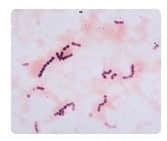Exam Details
Exam Code
:ASCP-MLTExam Name
:MEDICAL LABORATORY TECHNICIAN - MLT(ASCP)Certification
:ASCP CertificationsVendor
:ASCPTotal Questions
:572 Q&AsLast Updated
:Apr 15, 2025
ASCP ASCP Certifications ASCP-MLT Questions & Answers
-
Question 411:
India ink can aid in the visualization of the polysacchride capsules of yeast such as Cryptococcus neoformans.
Micro
India Ink is used to:
A. Visualize flagella
B. Visualize shape
C. Visualize capsule
D. Visualize cytoplasm
-
Question 412:
Thyroid-stimulating immunoglobulins, or TSI's, are IgG antibodies that can bind to thyrotropin (TSH) receptors on the thyroid gland. TSIs mimic the action of TSH, causing excess secretion of thyroxine and triiodothyronine. The TSI level is abnormally high in persons with hyperthyroidism due to Graves' disease. Which of the following is an autoantibody that binds to TSH receptor sites on thyroid cell membranes preventing thyroid-stimulating hormone binding?
A. Antithyroglobulin
B. Antimicrosomal antibodies
C. Thyroid-stimulating immunoglobulins
D. Thyroxin-binding globulins
E. Lupus erythematosus
-
Question 413:
Blood collected in CPDA-1 may be stored at 1 - 6 oC for up to 35 days.
How long may blood be stored using CPDA-1 preservative prior to transfusion?
A. 5 days
B. 15 days
C. 25 days
D. 35 days
-
Question 414:
Transpeptidase enzymes catalyze the final stage of peptidoglycan synthesis during cell wall formation. Beta-lactam antibiotics bind with these enzymes, interfering with their function. The transpeptidase enzymes are also referred to as PBP's, or penicillin-binding proteins.
Beta-lactam antibiotics interfere with cell wall synthesis by:
A. Binding with a transpeptidase
B. Preventing the final stage of peptidoglycan synthesis
C. Interfering with PBPs
D. All of the above
-
Question 415:
During primary hypothyroidism, where a defect in the thryoid gland is producing low levels of T3 and T4, the TSH level is increased. TSH is released in elevated quantities in an attempt to stimulate the thryoid to produce more T3 and T4 as part of a feedback mechanism.
Serum TSH levels five-times the upper limit of normal in the presence of a low T4 and low T3 uptake could mean which of the following:
A. The thyroid has been established as the cause of hypothyroidism
B. The thyroid is ruled-out as the cause of hypothyroidism
C. The pituitary has been established as the cause of hypothyroidism
D. The diagnosis is consistent with secondary hyperthyroidism
-
Question 416:
The correct answer which best fits the characteristics in this question is Mycobacterium tuberculosis.
What is the MOST likely identity of an acid-fast bacilli that showed buff colored, dry, heaped colonies; niacin, nitrate, and urease positive; and took 23 days at 35°C to grow?
A. Mycobacterium avium
B. Mycobacterium kansasii
C. Mycobacterium bovis
D. Mycobacterium tuberculosis
E. Mycobacterium leprae
-
Question 417:
Match each of the following:
1.
Ratio of cellular area to total area in the bone marrow section.
2.
Number of myeloid cells compared to nucleated erythroid cells.
3.
Use low power to estimate their quantity and appearance.
4.
Use Perls' Prussian blue stain.
A. Myeloid-erythroid ratio
B. Stored iron
C. Overall cellularity
D. Megakaryocytes
-
Question 418:
Although any one of the answers might be considered correct, a report of gram-positive cocci in chains provides sufficient information without going beyond what the observation might allow. In off-the record conversation with the physician, a technologist might divulge that the picture is consistent with Streptococcus; however, enterococci may have a similar Gram stain appearance, potentially leading to the wrong choice of empiric antibiotic agents.

The image shows the Gram stain prepared from the positive blood culture. What is the MOST appropriate report?
A. Gram-positive cocci
B. Gram-positive cocci in chains
C. Gram-positive cocci consistent with Streptococcus
D. Gram-positive cocci consistent with Enterococcus
-
Question 419:
In this case, the pH may become more alkaline, perhaps above 8.0, if the bacteria in the sample are proliferating during the extended room-temperature wait time.
A urine specimen was collected at 6:00 a.m. and remained at room temperature until it was received in the laboratory at 3:30 p.m. How may the pH of the specimen be affected by the extended time at room temperature if bacteria are present in the specimen?
A. The pH may become more acidic.
B. The pH may become more alkaline.
C. The pH would probably not be affected.
-
Question 420:
Interferon gamma serves various purposes in immunologic response, including the promotion of natural killer cell activity as well as decreased viral replication by using enzymes to decrease protein replication, both viral or host, inside of the cell.
The lymphokine most important for increased natural killer cell activity and decreased viral replication in cells is:
A. Interferon gamma
B. Interleukin 3
C. Interleukin 4
D. Interleukin 5
Related Exams:
Tips on How to Prepare for the Exams
Nowadays, the certification exams become more and more important and required by more and more enterprises when applying for a job. But how to prepare for the exam effectively? How to prepare for the exam in a short time with less efforts? How to get a ideal result and how to find the most reliable resources? Here on Vcedump.com, you will find all the answers. Vcedump.com provide not only ASCP exam questions, answers and explanations but also complete assistance on your exam preparation and certification application. If you are confused on your ASCP-MLT exam preparations and ASCP certification application, do not hesitate to visit our Vcedump.com to find your solutions here.